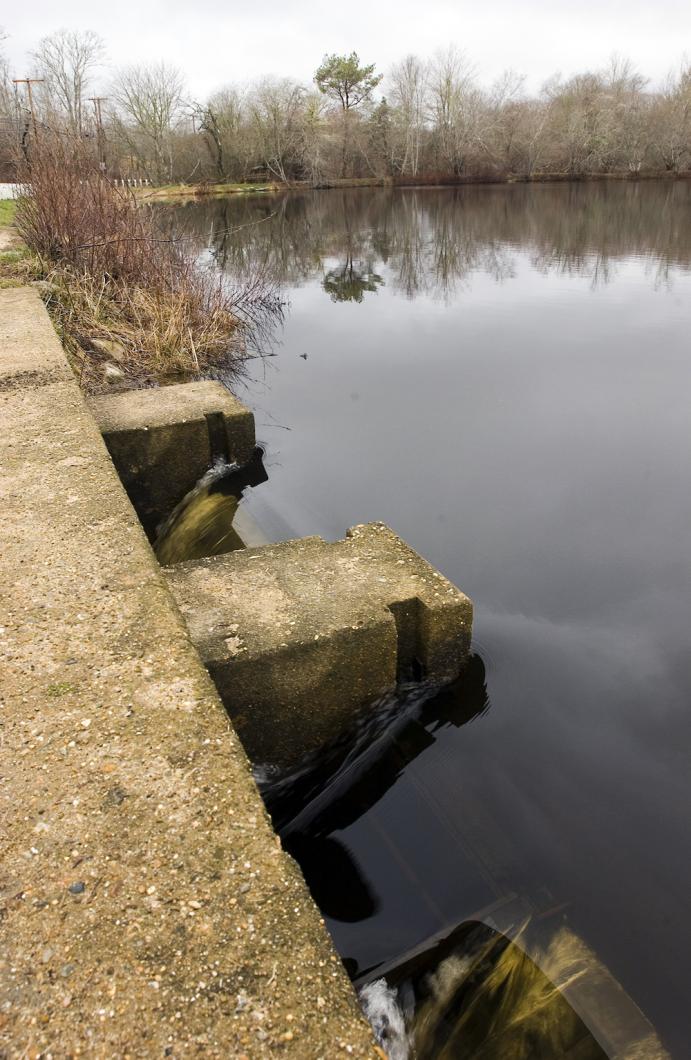The Mill Pond in West Tisbury, which serves as the unofficial gateway to town along the Edgartown-West Tisbury Road, has long served as a haven for passive and leisurely endeavors: bench-sitting, bird-watching, nature walks. At this pond, swimming is prohibited, boating is forbidden and even sunbathing along the shores is frowned upon.
This pastoral pond has become the unlikely source of heated debate around town, as two distinct camps have formed with markedly different ideas about how the pond should be preserved — or more accurately, whether anything should be done to preserve the pond at all.
A specially appointed Mill Pond committee believes the pond needs to be dredged to prevent it from drying up and becoming a marsh.
But many residents, including Kent Healy, a former Mill Pond committee member who stepped down in November after disagreeing with his colleagues, are opposed to dredging and believe the pond can be preserved with simpler and less costly measures, such as pulling weeds or increasing the height of the dam on the pond’s southern edge.
The question of whether to dredge could be decided at the annual town meeting on April 13, when voters consider an article from the Mill Pond committee asking them to spend $25,000 in Community Preservation Act funds to perform engineering and environmental studies in preparation for dredging the historic pond.
But before the town meeting, the Mill Pond committee will hold an informational meeting on Wednesday, April 7, at 7 p.m. at the Howes House, where residents are encouraged to make comments and ask questions about the funding request for engineering, and the overall plans to dredge the pond.
Bob Woodruff, chairman of the Mill Pond committee, said this week he feels strongly that dredging is the most effective way to preserve the pond for generations to come. He pointed to a 2006 study by Aquatic Control Technology that makes several recommendations for repairing the pond, including dredging, hydro-raking and weed-pulling.
Although the report did not choose a single option, it makes a strong case for dredging, outlining a plan to take approximately 10,000 cubic yards of material from the bottom of the pond at an estimated cost of between $400,000 and $600,000.
“Dredging is the most recommended long-term management alternative for the pond, and the only technique that will address, at least in part, both the excessive growth of rooted vegetation and the significant accumulation of sediment,” the 2006 report states. “Dredging is certainly the only technique that can appreciably restore the pond’s water depths.”
Mr. Woodruff said his committee wants to scale back that plan and dredge a smaller area, around 1.8 acres, at a cost of around $200,000. He argued that dredging was the most cost-effective option for preserving the pond. While other techniques such as weed-pulling are cheaper, that will only remove the top of the vegetation and not the root systems, he said. And other techniques such as hydro-raking have yet to be proven and will likely cost more over the long run, he argued.
“I’m about as fiscally conservative as many of the people who are against [dredging the pond]. And I think this is actually the best deal we will find for the pond; it will give us the most bang for our buck,” said.
Mr. Woodruff said the pond has historically been dredged every few decades.
In the colonial times they dredged the pond using equipment dragged by oxen and livestock. And when they last dredged the pond about 50 years ago, work crews used a piece of equipment that literally threw a large metal bucket into the pond and then dragged it back to shore, collecting material from the bottom along the way.
He said a dredge of the pond is long overdue.
“We’re seeing emerging vegetations in the middle of the pond, the type of growth you normally would see along the edges,” Mr. Woodruff said. “That’s the first sign the pond is converting into a marsh . . . at some point it could look just like the area directly next door, sort of a woody, maple swamp.”
When reached by phone this week, Mr. Healy said he still opposes dredging the pond.
“I have yet to see any evidence that [dredging] is necessary. Maybe it will be needed down the road, I just don’t know. But I see no evidence right now indicating it is needed,” he said.
Mr. Healy said the town should instead make some decisions regarding Mill Brook, which flows into the pond, before they embark on a costly dredge project. He has put together a map showing the directional flow of Mill Brook, which shows a large portion of the brook — as much as 80 per cent — being diverted towards Parsonage Pond at the dam near Scotchman’s Lane.
The map also shows a portion of the water flowing out of Mill Pond heading towards Maley’s Pond off Sweet William Way.
Mr. Healy said the town should come up with a plan outlining who legally gets the water, and how much.
“There are some years there just isn’t enough water. In 2002, for example, there was a very dry summer, and people were all trying to get that water. We need to straighten that out before it becomes a problem,” he said. “A pond is not a pond unless there’s water in it, and right now we need to decide who has legal rights to the water, and make sure that water continues to arrive at [Mill Pond].”




Comments
Comment policy »